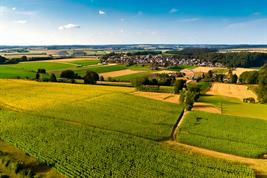17.10.2024

A recent study with the participation of the Leibniz Centre for Agricultural Landscape Research (ZALF) has investigated the extent to which the spatial diversification of arable land at the district level influences the yield fluctuations of important field crops in Germany.
The results of the study, published in Environmental Research Letters, show that diversification alone is not enough to significantly reduce yield volatility.
Between 1977 and 2018, the yields of winter wheat, winter barley, silage maize and winter oilseed rape were analyzed at the district level. The aim was to assess the stability of combined yields with different land use.
“Our analysis shows that an optimized distribution of cropland could reduce yield fluctuations by an average of 24%, but it also went hand in hand with a decline in biodiversity,” explains Prof. Frank Ewert, co-author of the study and Scientific Director at ZALF.
What does spatial diversification mean?
The term spatial diversification refers to the practice of growing different crops in different regions or in different fields within a district. The idea behind it is that spreading the acreage over several plant species reduces the risk of extreme weather events or other environmental factors endangering the entire harvest in one year. For example, if a county grows not only a single crop such as wheat, but also barley, corn and canola, it is hoped that the overall crop will be more stable because the plants respond differently to weather or soil conditions.
Diversity not always the key to stability
The researchers found that stable yields were more likely to be achieved by growing robust individual crops such as winter wheat and winter barley, rather than by relying on the diversity between different crops. This is an interesting finding, as diversification is often seen as a way to minimize risk. Portfolio theory, originally from the world of finance, was used to optimally distribute the acreage and minimize yield volatility.
Social relevance and future prospects
The study provides important insights for agriculture, which is increasingly having to adapt to climate change. Extreme weather events such as droughts and floods make reliable yield planning more difficult. However, the results show that choosing stable crop varieties could be an effective strategy for minimizing yield losses. Prof. Ewert emphasizes: “Future research should focus on optimizing cropping systems to find a balance between species diversity and yield stability.”
Prof. Heidi Webber, co-author of the study at ZALF, explains: ”Our research makes it clear that not every diversification measure has an equally positive effect on yield stability. We need to develop differentiated strategies that take into account both ecological and economic factors.”
Further research needed
In further studies, the model of diversification is to be refined and expanded to include additional plant species. Investigating the long-term effects on soil fertility and crop yields also remains a key research objective.
Funding reference:
The study has emerged from the work of the DFG-funded Young Investigators Academy Agroecosystem Research at ZALF and is also financed by ZALF's budgetary funds.
Project partners:
- Leibniz Centre for Agricultural Landscape Research (ZALF)
- University of Helsinki
- University of Hohenheim
Further Information:
Text disclaimer:
This is a summary generated with the assistance of artificial intelligence from the original text: Ahrends, H.E., Piepho, H.-P., Sommer, M., Ewert, F., & Webber, H. (2024). Is the volatility of yields for major crops grown in Germany related to spatial diversification at county level? Environmental Research Letters, 19(10), 104061.
https://doi.org/10.1088/1748-9326/ad7613.
Published under the CC BY 4.0 license
https://creativecommons.org/licenses/by/4.0/.
The text has been carefully reviewed and revised in accordance with ZALF's AI regulations.
